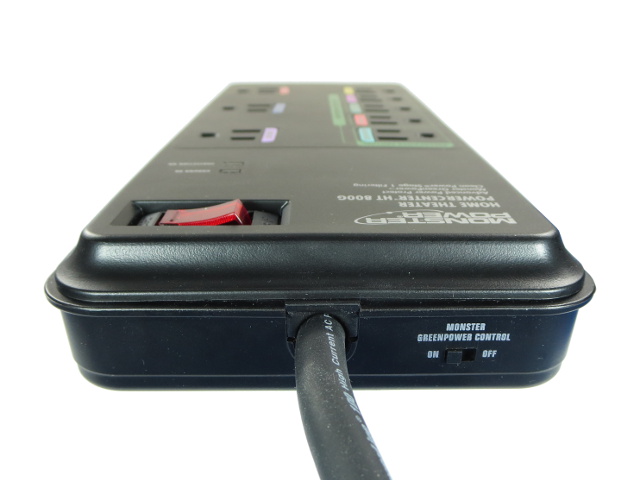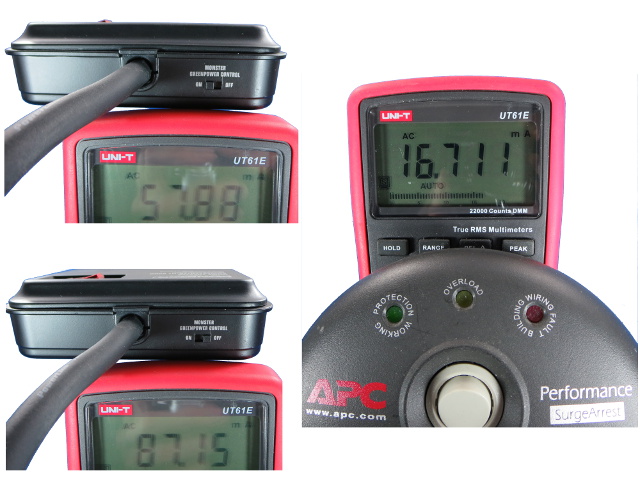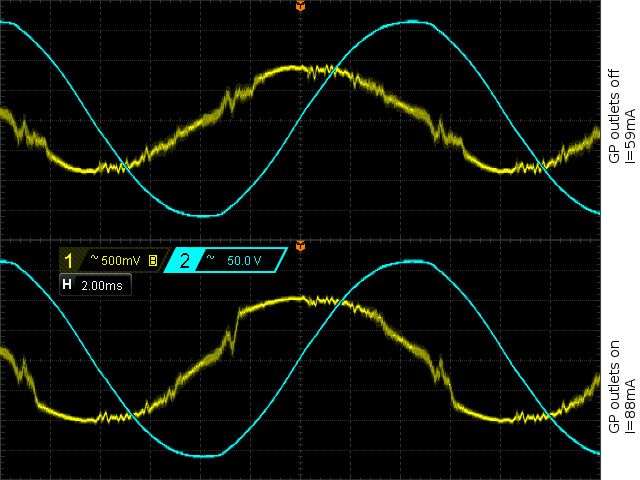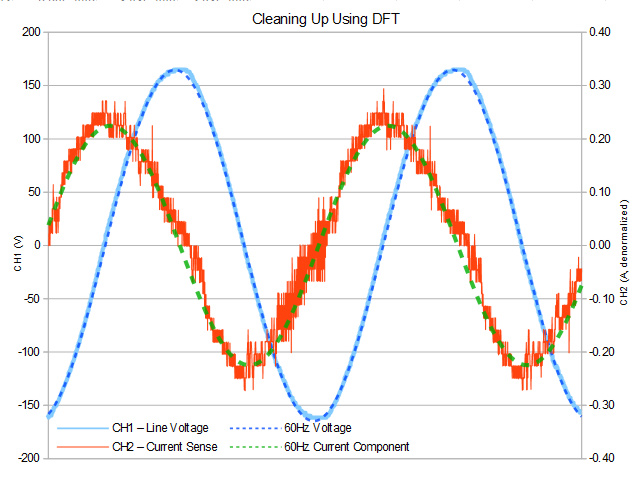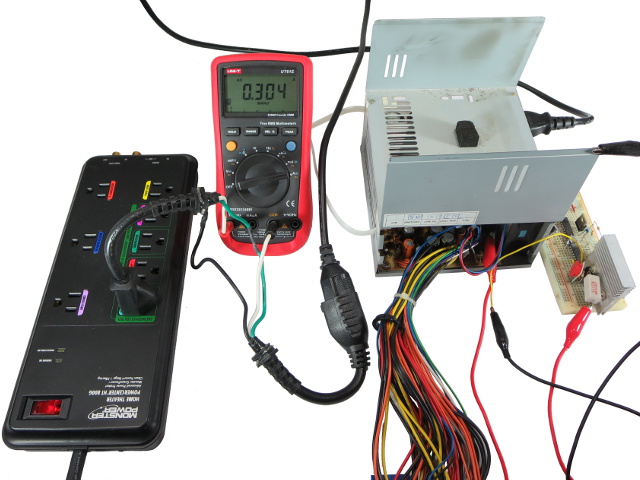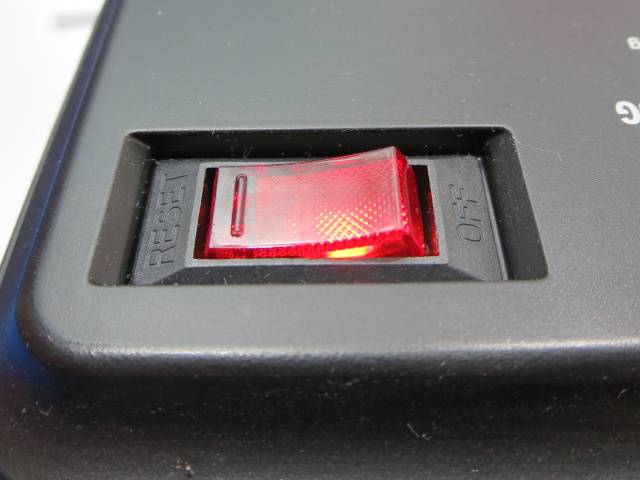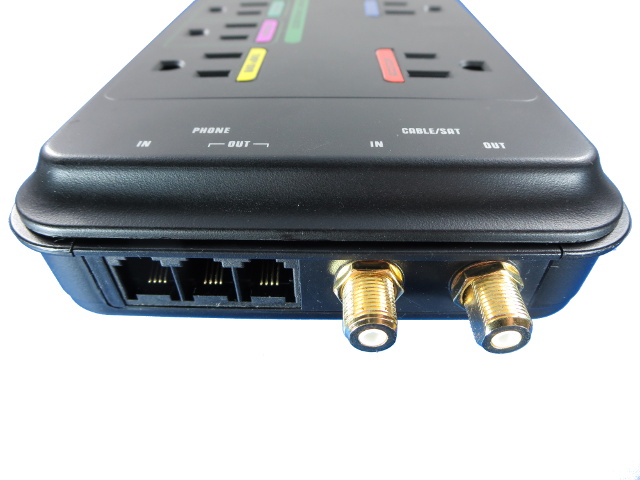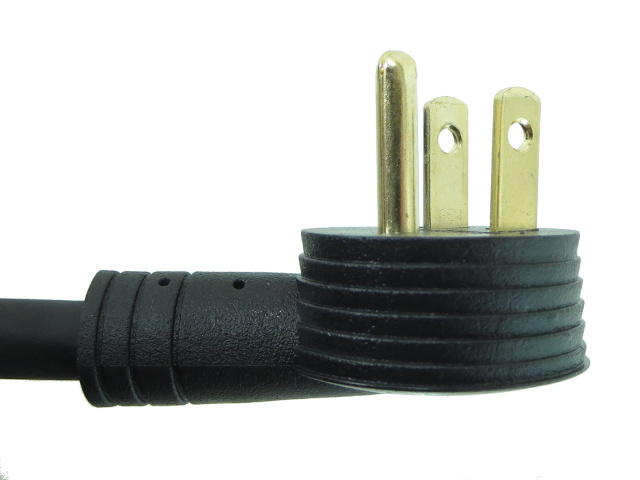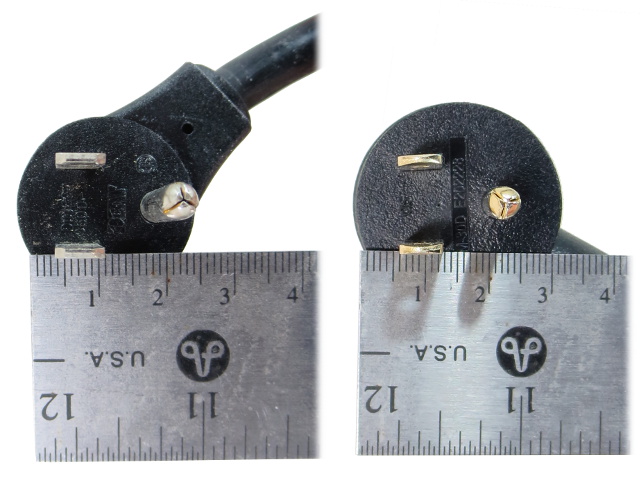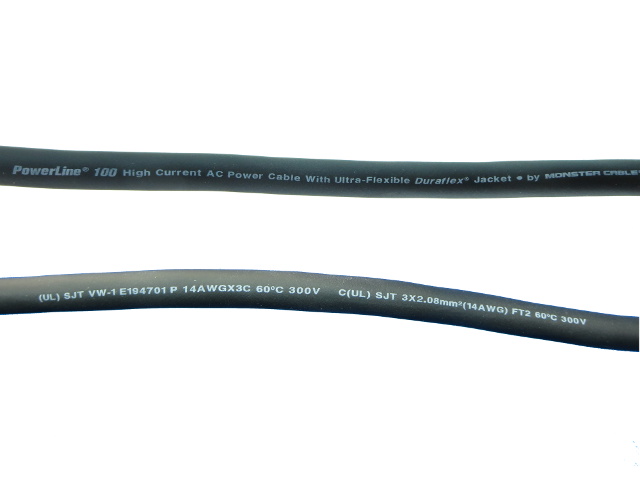Monster PowerCenter HT 800G Tear-Down
At The Top
The cable enters from the top, just beside the GreenPower switch. If going green is not your thing, Monster's GreenPower is causing you unexpected issues or you read the warnings about potential data loss and decided not to try your luck, this tiny switch gives you that option.
The Cost Of Going Green
The extra circuitry required to manage Monster's GreenPower and Dual Mode Protection requires power of its own. With the GreenPower outlets inactive, the HT800G draws 58mA of standby current versus 87mA with the GreenPower outlets forced on using the bypass switch. For comparison's sake, I also included the current draw from one of my APC SurgeArrest, clocking in at 17mA.
Note that since both units contain reactive components like chokes and X-caps, and active components like diodes, these figures are apparent current, which is a combination of active, reactive and distortion currents. Isolating the active current draw would require separating the 60Hz current component and calculating its phase shift relative to voltage or a power analyzer. At 114V line voltage, those currents would translate into apparent powers of 6.6VA, 9.9VA and 1.9VA respectively.
Measuring Power
Phase shift is easy enough to measure. Introduce any form of resistance on the neutral wire, measure the resulting voltage and then measure phase difference with line voltage. Here, my multimeter's mA-range current shunt acts as my arbitrary resistance in the neutral path.
After eyeballing the waveform distortion and noise out, current is leading voltage by about two divisions, which translates to 86° of forward phase shift, or a capacitive power factor of 0.063 if you prefer. This means the HT800G presents an almost entirely capacitive load with nothing plugged into it, regardless of whether GreenPower outlets are on or off. Since many countries' power utilities meter residential customers only for active power, less than 7% of the previously calculated figures would be billable, or less than 0.7W in the HT800G's case.
Fancy Mathematics
For the sake of fun, curiosity and checking that I still remember how to do a Discrete Fourier Transform, I decided to export waveform data to a CSV file, put together a spreadsheet to compute the 60Hz DFT over 30,000 points spanning 600ms and plot the raw and extracted 60Hz signals for sanity-checking, seeing if the calculated signals line up with the raw data for both phase and amplitude. This far more accurate measurement came out as 83.6º or a PF of 0.11 with GreenPower outlets forced on (GreenPower off) and 82.7º or 0.13 PF with the GreenPower outlets off.
Three degree eyeball error? I call that fair enough. This means the HT800G still uses less than 1W.
Get Tom's Hardware's best news and in-depth reviews, straight to your inbox.
Measuring Thresholds
How much current must the Master device draw before the GreenPower outlets get turned on and off? I used a PC supply as the load, measured its AC input current as I increased power draw on the 5VSB output until the GreenPower outlets turned on, then repeated the process backwards until the slave outlets turned off. Turn-on occurred at 305mA, while turn-off occurred at 165mA, corresponding to 35VA and 19VA respectively on 114V AC line voltage.
About That Switch
When I think of switches, I usually think about snap-action types that maintain their on/off operation until the lever reaches the tipping point and snaps in the opposite state.
While doing the limit measurements, I used the switch many times and noticed how little pressure it took on the Off side to make it break contact while still in the On/Reset position and how “spongy” the movement felt. I revisited the breaker-switches in my growing pile of spare power strips and they all had similarly spongy On-to-Off feels. They do all have the expected snap action going from the Off to On position, though.
I never really paid attention to it before, and the main reason this surprised me is because distribution panel breakers have the exact opposite feel to them; they snap Off but have a spongy travel towards the On position.
The Bottom End
I am not quite sure how I feel about putting the cable and phone protections at the bottom. The mounting slots on the back of the unit are clearly meant for vertical mounting. But in a vertical orientation, you end up with the power cord sticking up to keep the phone and coax pointing down or vice versa. On the floor, space to let the coax bend might also be inconvenient. Top connections aren't as pretty, but they have fewer potential usability issues. As usual with higher-end AV connectors, the RF studs are gold-plated. To complete the gold-plated-everything theme (at least as far as visible parts are concerned), the washers and nuts are as well.
Plugging In
One of Monster's claims to fame with the HT800G is its “FlatProfile” plug and cable. I did a quick visual comparison against my SurgeArrest, and APCs' plugs have a lower overall profile by about one millimeter since they lack Monster's cable over-mold bulge.
With that said, Monster's plug is about 40% bigger than APC's (32mm diameter versus 27mm), and combined with the serrated ridges, it makes getting a firm grip on the plug to pull it out really easy and comfortable.
Safety First Or Coincidence?
I wanted to put in photos to illustrate how much better the Monster plug fits in-hand, but upon reviewing images, I could barely tell them apart. So, I decided to enlist my ruler's help. On the left, we have APC's SurgeArrest's plug with the prongs coming within 3mm of the grip's edge, while Monster's on the right nearly doubles the safety margin with 5mm.
Safer plug designs are always nice to have, and I find them especially important with these low-profile plugs where pulling from the cord to unplug is not an option. Of course, most people rarely relocate their relocatable power taps on a regular basis, so how easy they are to grab might be a non-issue to you.
More Cable
All of the power strips that have passed through my tear-down treatment used stiff PVC or similar power cords. The HT800G uses Monster's house-brand “PowerLine 100” cable, which is considerably more flexible, though not to the point of straightening itself under its own weight like high-quality power tool cables. The matte semi-slick outer jacket's texture feels like neoprene, a more durable type of synthetic rubber.
-
bit_user I long ago replaced my Monster Power A/V surge protection / power filtering product with a Panamax unit, which were peerless at the time. It would be nice to know how their quality rates, these days.Reply
Oh, and thanks for yet another excellent teardown. -
toddybody Not trying to be negative...but Tom's is really confusing me lately;Reply
Continued Power Strip Teardowns (admittedly boring, though technically interesting) juxtaposed against some goofy op eds (yes Im talking about you, Mr. Used Macbook)...with a considerable lag in reporting tech news behind it's peers (i.e., GTX 970 VRAM-Gate, recent AMD 3xx tweets).
Tom's, you ARE an AWESOME site because of your attention to:
PC Component Reviews (though a topical review of Apple Products wouldn't offend master race folks either)
Manufacturer Q&A Articles
System Builders and Benchmarks!
...anyhoo, please dont loose the spark that makes you a special site.
PS: How about a refreshed customer water loop guide?
-
bit_user Reply
Why not complain about this in the comments on those Op Eds and the late news articles, then?15254691 said:Not trying to be negative...but Tom's is really confusing me lately;
Continued Power Strip Teardowns (admittedly boring, though technically interesting) juxtaposed against some goofy op eds (yes Im talking about you, Mr. Used Macbook)...with a considerable lag in reporting tech news behind it's peers (i.e., GTX 970 VRAM-Gate, recent AMD 3xx tweets).
Or, better yet, perhaps the site feedback forum (might actually get some results):
http://www.tomshardware.com/forum/forum-9.html
-
Steelwing Now show us a tear-down of a professional level surge protector that doesn't use MOVs (is a non-sacrificial protector) but cancels the surges in another manner.Reply
I want to see something from SurgeX, Zero Surge, or Brick Wall. -
Daniel Sauvageau Reply
Send an email to SurgeX and try convincing them to contact me and send me a review sample. At $200 and up, those fancy units are far too expensive to tear down at my own expense.15255097 said:Now show us a tear-down of a professional level surge protector that doesn't use MOVs (is a non-sacrificial protector) but cancels the surges in another manner.
I want to see something from SurgeX, Zero Surge, or Brick Wall.
If I did receive one, I would also feel compelled to try giving its protection some sort of work-out to prove a few points based on what I read in their patents during a long argument with other forum posters about SurgeX many months ago.
(Hmm, looks like THG ate my signature and won't let me set it again.) -
babernet_1 I really hate these new horizontal windows. They usually don't work for me. I have Google Chrome and a cable modemReply -
Daniel Sauvageau Reply
Then you might be happy to read that my next tear-down won't be a power strip... and my next two stories after that might not be either, now that I have enough basic test equipment to start building my own and dig into more intricate stuff - THG has lent me an oscilloscope last month and the Eyeball + DFT power factor slides in this story were my first of likely many future uses of it in a story... a hint of on of the things I might end up using it for at least until I get a more convenient method of obtaining the same measurements.15254691 said:Not trying to be negative...but Tom's is really confusing me lately;
Continued Power Strip Teardowns (admittedly boring, though technically interesting) juxtaposed against some goofy op eds
I started doing power strips because it was something simple sparked by an unexpected failure that got more interest than expected from readers. The wild manufacturing quality variability helped keep things entertaining so I will probably continue doing them whenever I get something potentially different enough to turn into a story - you never know where the next shocking revelation will come from until you look and it jumps into your face!
-
tsumeone I personally love these teardowns. Goes to show you that money is not always quality, but sometimes it can be. I'd personally love to see a teardown of one of those highly regarded metal Tripp-Lite units, the ISOBAR Ultra ones. I wonder just how much quality is actually in those, but I don't want to bust mine open.Reply -
06yfz450ridr i have a few panamax pdus that we pulled from a job literally 20+ of them. I use one for my tv equipment and a panamax ups for my pc stuff.Reply
I could donate a pdu to disassemble if you would like here is the model #m4315-pro -
Daniel Sauvageau Reply
That would certainly be much appreciated.15258021 said:i have a few panamax pdus that we pulled from a job literally 20+ of them. I use one for my tv equipment and a panamax ups for my pc stuff.
I could donate a pdu to disassemble if you would like here is the model #m4315-pro
